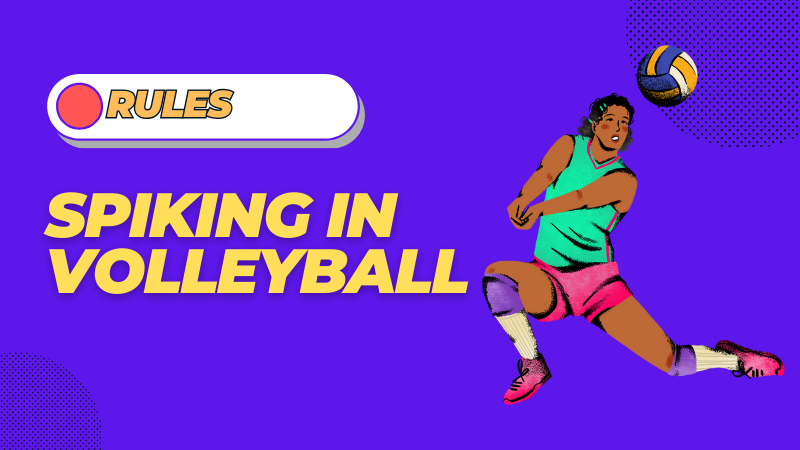Spiking in volleyball is more than just an exhilarating move; it’s an art form that can instantly turn the tide of a match. As one of the most powerful offensive plays, spiking requires skill, timing, and brute strength. But mastering the spike can be challenging. It’s a complex maneuver with potential pitfalls, from the right positioning and arm swing to achieving the perfect jump.
Did you know spiking dates back to a volleyball game played in the Philippines in 1916? Despite its history, many aspiring players need help with this essential skill, often frustrated by the nuances and intricacies involved.
In this article, I’ll demystify spiking in volleyball, breaking down the steps and techniques that will help you hit the ball harder, spike with precision, and transform your game. Whether you’re a beginner looking to learn the basics or an experienced player aiming to enhance your power and accuracy, this guide promises to elevate your spiking skills.
What Is Spiking in Volleyball? Understanding the Volleyball Spike Technique
Spiking in volleyball is the offensive play where a player forcefully swings the ball with their open palm sharply downwards over the net and into the opposing court. This move makes it difficult for the opposing team to recover the ball, often resulting in a point for the spiker’s team.
Originating as early as 1916, spiking has become a hallmark of competitive volleyball. It’s a dynamic and demanding move that requires precise coordination between the player’s body positioning, arm swing, jump, and timing. More than just an attack, spiking adds excitement to the game, and its quickness, power, and accuracy make it one of the most thrilling aspects of volleyball.
Despite its effectiveness, spiking can be challenging to master. Proper footwork, core strength, and the ability to hit a volleyball at the top of your jump are all essential. Yet, when executed with skill, a spike can turn the tide of a match, making it a vital tool in any volleyball player’s repertoire. Whether on the beach or the indoor court, spiking remains a crucial skill that distinguishes great players and creates unforgettable moments in the game.
Also, Read: Why Do Volleyball Players Tape Their Fingers?
Spiking in Volleyball – Step by Step Guide
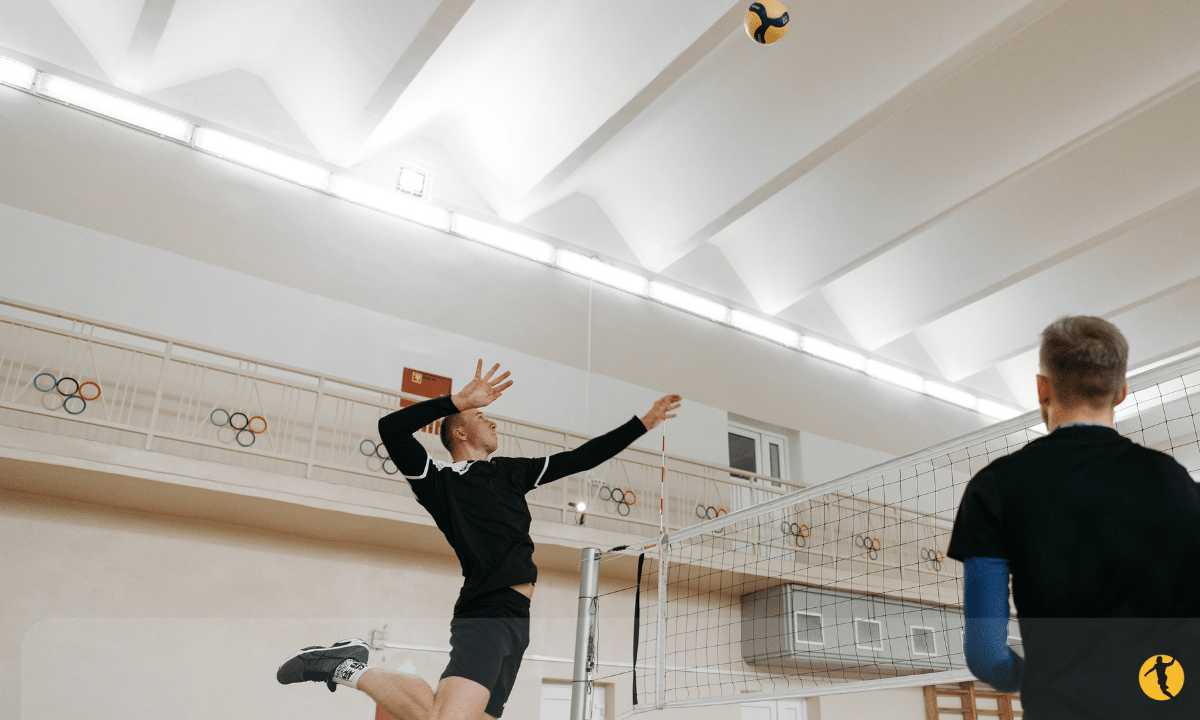
Transitioning from the dynamic nature of spiking, let’s delve into the mechanics that make this skill vital in volleyball. Understanding how to execute a spike properly is essential, not only for scoring but also for enhancing the overall excitement of the game. Here, we’ll break down the step-by-step process, making it comprehensive and easy to grasp, even if you’re new to the game.
- Position Yourself: Stand at the front of the court, about a step or two inside the 3-meter line. Be close enough to the net to reach it as you jump, but not so close that you’ll run into it.
- Prepare Your Arm: Begin with your arm in a shooter position, elbow raised above the head, hand open and relaxed, palm facing outward, away from the face. On contact, either keep the hand open, tipping with the fingers or snap downwards to create topspin.
- Jump and Swing: Utilize your core, feet, and arms to create a powerful jump, followed by an arm swing. This coordinated movement aims to make contact with the ball at the peak of your jump, directing it sharply into the opponent’s court.
- Work on Timing and Technique: Practice the sequence regularly to enhance your timing, positioning, and hitting. Work on increasing your jump and approach to perfect your spiking ability.
Remember, spiking requires a combination of power, accuracy, and skill. Following these steps and practicing consistently can develop a strong spiking technique that can become a game-changer in your volleyball matches. Whether you’re a beginner or a seasoned player, these fundamentals are a strong foundation for mastering the art of spiking in volleyball.
How Can I Spike the Ball Harder? Techniques to Improve Your Volleyball Spike Approach
Transitioning from the basic mechanics of spiking, we now focus on enhancing your spike’s power. Spiking with more force can significantly affect the game’s pace and put extra pressure on the opposing team. In this section, we’ll explore how you can condition your body and hone your technique to spike the ball harder.
Conditioning to Spike Harder
When hitting the ball with more power, building your core and conditioning your arm is essential. Your core plays a vital role in the hitting motion; exercises like crunches, planks, and twisting will help you generate force in the air as you swing. Additionally, by rotating and whipping your forearm forward, you can increase the rapid movement of your hand toward the ball, imparting more topspin. Practicing specific weight training focused on volleyball can further enhance your striking efficiency.
Also, Read: Can You Kick the Ball in Volleyball?
Using Proper Technique to Spike Harder
Enhancing your spike’s force is not only about physical strength but also about the right technique. Proper timing is critical here. Here’s how you can improve:
- Work on Timing: Take your time with all parts of the motion. The more you perfect your skill base, the better you focus on your jump and timing, positioning yourself for a stronger hit.
- Use Your Whole Body: Utilize your core, legs, and arms in unison. The power of a spike comes from the entire body working together, not just the arm.
- Aim Precisely: Focus on aiming the ball at the height of your jump, ensuring your strike is accurate and powerful.
- Practice Regularly: Regular practice with a coach or specific drills can refine your technique, making your spikes more potent and effective.
By diligently working on conditioning and technique, you can transform your spiking ability, making it a formidable weapon in your volleyball arsenal. It’s a combination of dedicated practice and understanding of the precise movements that leads to a harder and more effective spike.
Spiking in Volleyball: Why Is It Important?
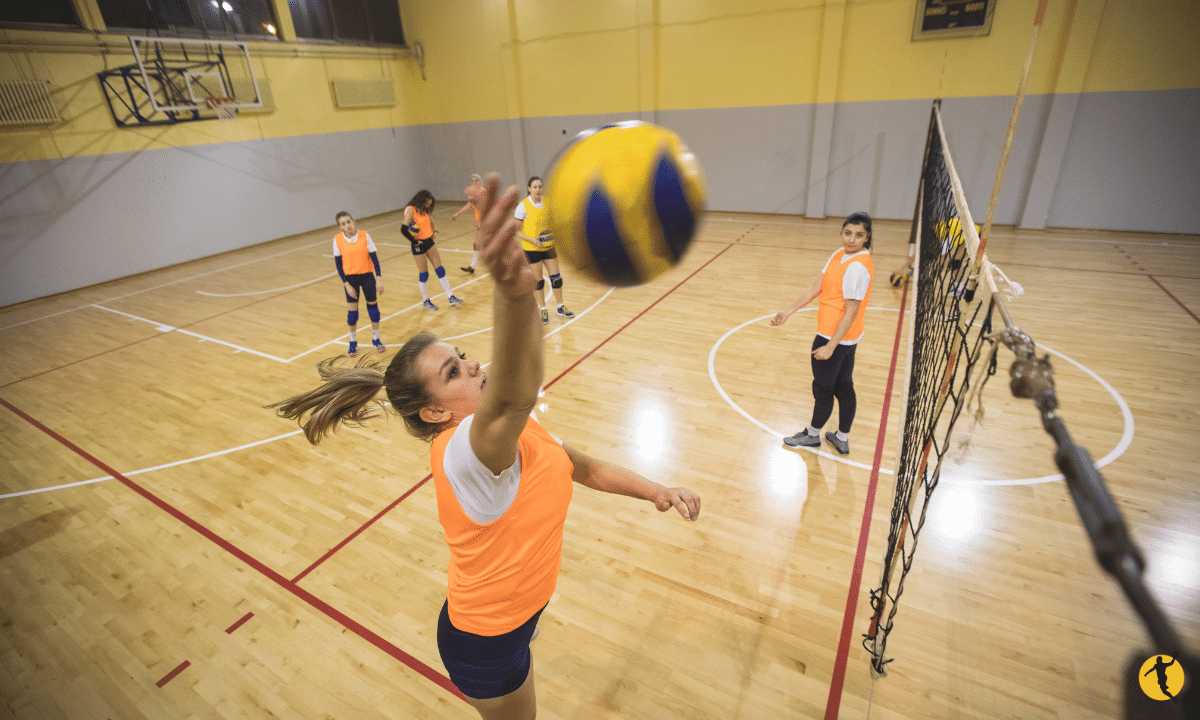
Spiking in volleyball isn’t just a spectacular play that energizes the crowd; it’s a vital part of the game’s strategic depth. This section highlights why spiking is crucial in the volleyball game.
- Scoring Opportunities: The primary aim of spiking is to score points. By attacking the ball with quickness, power, and accuracy, you make it challenging for the opposing team to recover and return it, thereby increasing your chances of scoring.
- Creating Pressure: A well-executed spike puts immense pressure on the opponent’s defense. It forces them to make rapid decisions, which can lead to mistakes or weak returns, giving your team an advantage.
- Enhancing Game Excitement: From a spectator’s perspective, spiking adds thrill and excitement. A well-timed spike’s sheer power and precision can elevate the game’s energy level, keeping fans engaged.
- Tactical Gameplay: Spiking also plays a role in the strategic aspect of the game. Knowing when and how to spike can disrupt the opponents’ formation, creating opportunities for your team. It allows for variations in attacking, keeping the opponents guessing and on their toes.
- Personal Development: On an individual level, mastering the art of spiking contributes to a player’s overall growth and confidence. It gives players a sense of accomplishment and provides a valuable tool to influence the game positively.
- Encourages Team Coordination: Successful spiking requires seamless collaboration between the setter and the spiker. This coordination fosters teamwork and understanding among players, contributing to the team’s success.
In summary, spiking in volleyball is more than just a physical move; it’s a multi-dimensional aspect that impacts scoring, strategy, excitement, personal growth, and teamwork. Mastering this skill enhances individual and team performance, making it a critical component in volleyball. Whether you’re a player aiming to improve your game or a fan seeking to understand the sport better, recognizing the importance of spiking enriches your connection with volleyball.
How Many Times Can You Spike in Volleyball?
In volleyball, a team can only touch the ball three times before it must go over the net, with the spike often being the third hit. This means a player can only spike the ball once per rally, except in specific situations like when the opposing team blocks the first spike or when different body parts are used for consecutive touches.
The 3-hit rule is an essential part of the game, creating a rhythmic flow and requiring strategic planning from the players. Any player can execute the first hit, but the next two hits must come from different players. Spiking the ball, or hitting it hard across the net, is usually the final step in this three-hit sequence.
There are exceptions to this rule, such as when the first spike is blocked or when the ball is touched twice consecutively by different body parts. But overall, the 3-hit rule encourages teams to develop more complex plays and avoid sending the ball back and forth over the net. This fosters creativity and skill development on the volleyball court, enhancing the excitement and competitive nature of the sport.
Can Any Player Spike the Ball During Play in Volleyball?
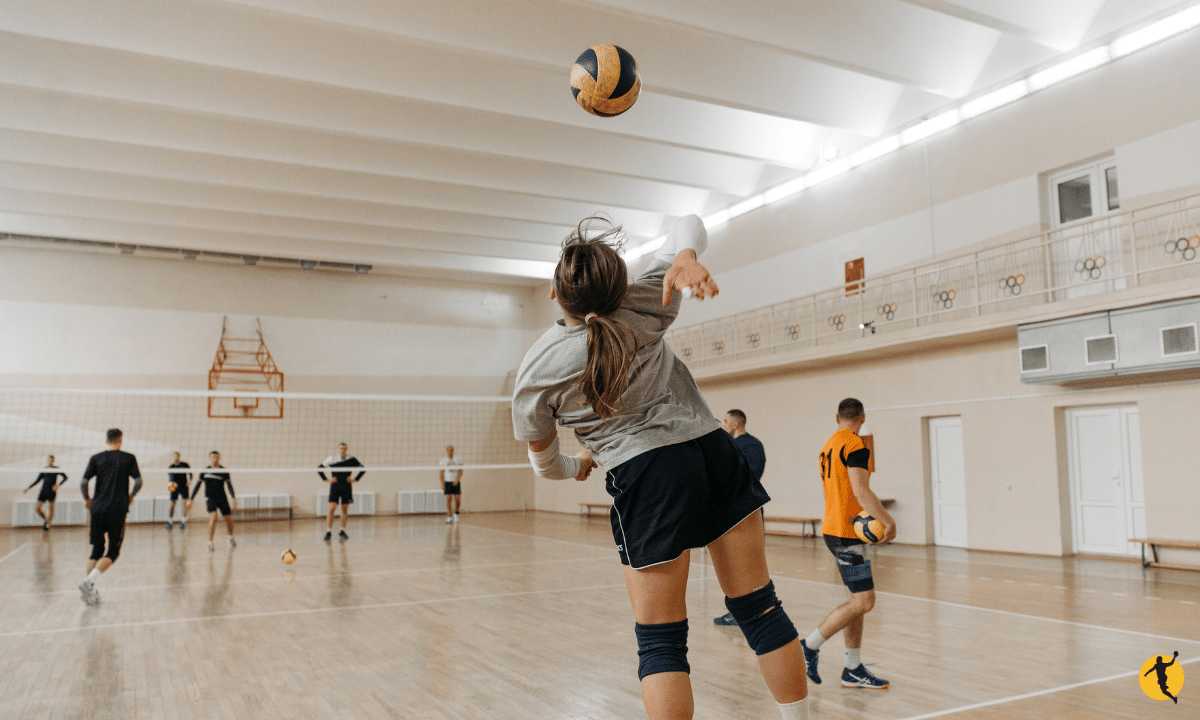
Any front-row player is allowed to spike the ball in volleyball, provided they adhere to the game’s rules and regulations. However, back-row players must follow specific restrictions to spike the ball.
Allowing front-row players to spike the ball opens up a world of offensive strategies and opportunities, but the rules differ for those in the back row. A back-row player can spike the ball but must initiate their jump from behind the 3-meter (10-foot) line, known as the attack line. If they step on or over this line during the run-up for the spike, it’s considered a fault, and the point goes to the opposing team.
These regulations ensure a balanced and fair game, providing tactical challenges that make volleyball an engaging and strategic sport. Whether you’re a front-row hitter aiming to attack the ball close to the net or a back-row player looking to make an impact from further back, understanding these rules can greatly enhance your performance on the volleyball court.
How to Spike a Volleyball if You Are Short? Learn How to Spike with Effective Drills
Height might be seen as an advantage in spiking a volleyball, but it’s certainly not the only factor determining success. Even if you are shorter, you can still excel in spiking by focusing on technique, timing, and intelligence on the court. Here’s how:
- Work on Your Jumping Technique: Improve your vertical jump by incorporating plyometric exercises and strength training. Focus on exercises that target your legs and core, enhancing your power and explosiveness.
- Perfect Your Approach: A well-timed 3 or 4-step approach can significantly enhance your ability to reach the ball at its highest point. Work on coordinating your steps, speeding up your approach, and hitting the ball at the peak of your jump.
- Improve Your Arm Swing: Your arm swing contributes greatly to your spiking power. Practice swinging your arm back and snapping your wrist as you contact the ball. This technique will maximize the force of your hit, even if you can’t jump as high.
- Use Intelligence and Deception: You don’t need to overpower taller blockers. Instead, use strategic hits like tips, roll shots, and angles to find open spaces on the court. Being clever and unpredictable can be just as effective as a hard spike.
- Communicate with Your Setter: Working closely to set the ball at your spike’s optimal height and location can make a big difference. Good communication and understanding with your setter can lead to more successful hits.
- Embrace Your Role: Sometimes, being shorter means being quicker and more agile. Utilize these attributes to your advantage, playing volleyball smartly and adapting your game to what works best for you.
- Keep Practicing and Be Persistent: Height might be an advantage, but it’s unnecessary. With determination, continuous practice, and a focus on improving your volleyball skills, you can become an effective spiker regardless of height.
In volleyball, technique, intelligence, and determination often triumph over physical attributes. Concentrating on these areas can turn what might seem like a disadvantage into an opportunity to stand out on the court.
Also, Read: Can You Block a Serve in Volleyball?
How Can I Practice Spiking Alone?
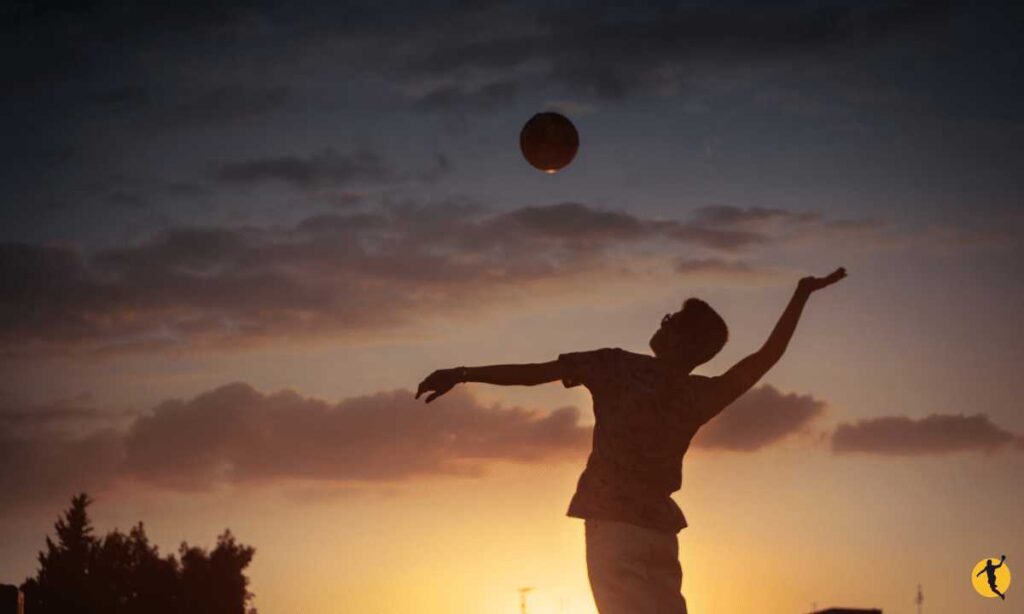
Practicing spiking alone might seem challenging, but with creativity and dedication, you can effectively work on your spiking skills even when you don’t have a partner or team. Here’s a step-by-step guide to help you practice spiking on your own:
- Find the Right Space: Locate a suitable area to practice, such as a park with a volleyball net or even against a wall. Make sure the space allows you enough room to move and jump safely.
- Use Props and Tools: If you can access tools like a ball rebounder or hitting trainer, these can be fantastic aids. Otherwise, simple props like a chair or even a pile of bags can serve as a makeshift setter.
- Work on Your Approach: Practice your 3 or 4-step approach without the ball first. Focus on footwork, speed, and coordination. Once you feel comfortable, add the ball to the sequence.
- Practice Toss and Spike: Toss the ball high into the air and practice your approach, jump, and arm swing to spike the ball. Aim for a particular spot to improve accuracy.
- Wall Hitting Drill: A wall can be a great tool if you don’t have a net. Stand a few feet from the wall and practice hitting the ball against it. Focus on your arm swing and try to hit the same spot repeatedly.
- Use Visualization Techniques: Visualize different game scenarios, imagining where blockers might be and practicing different types of hits like roll shots or angle hits.
- Record and Analyze: If possible, record and analyze your practice sessions later. Look for areas of improvement in your technique, approach, and timing.
- Incorporate Conditioning: Work on exercises that improve your vertical jump and overall fitness. Plyometrics, leg exercises, and core workouts can enhance your spiking ability.
- Be Patient and Consistent: Practicing alone requires self-discipline and patience. Set goals and be consistent in your practice. Track your progress over time.
- Safety Considerations: Always warm up properly before practicing, and be mindful of the surface you are playing on. Safety should always be a priority.
While practicing with a team or coach is often the most effective way to improve, remember the value of solo practice. By focusing on the key components of spiking and using the resources available, you can make significant strides in your ability to spike the volleyball, even when practicing alone.
Conclusion
Spiking in volleyball is an integral aspect of the game, a powerful offensive play that can be thrilling and decisive. Understanding the rules surrounding spiking, including the 3-hit rule, allows volleyball players to utilize this technique effectively.
From the history of spiking to the techniques for practicing alone, this article has explored various facets of this vital move. We’ve learned that spiking isn’t confined to certain players; even those with a shorter stature can master it with proper technique and practice.
Whether you’re a beginner trying to learn how to spike or an experienced player looking to refine your skills, the insights shared here can guide you in your journey to becoming a more adept and strategic volleyball player.
FAQS
What Is Spiking Called In Volleyball?
Spiking in volleyball is hitting the ball sharply over the net into the opposing team’s court. It’s an offensive play where a player jumps and swings their arm to strike the ball with an open hand, sending it downward at a steep angle. The goal is to make it difficult for the opposing team to recover the ball, often leading to a point for the spiking team.
How Do You Spiking in Volleyball?
Spiking in volleyball requires a combination of timing, power, and technique. To spike the ball, a player must first approach the net with a series of quick steps, timing their jump to meet the ball at the highest point of their reach. Using an open hand and a powerful arm swing, they hit the ball sharply downwards over the net, aiming to find an open spot on the opposing team’s court. Proper footwork, arm swing, and body positioning are essential to executing a successful spike.
What Is Spiking and Blocking In Volleyball?
Spiking and blocking are two essential skills in volleyball. As described earlier, Spiking is an offensive attack aimed at sending the ball into the opponent’s court with force and precision. Blocking, on the other hand, is a defensive move where one or more players jump near the net to prevent a spiked ball from coming over. By using their hands and arms to form a “wall,” they try to deflect the spiked ball back into the opponent’s court or at least slow it down, making it easier for their teammates to play the ball. Both spiking and blocking require coordination, timing, and strategic positioning on the volleyball court.

